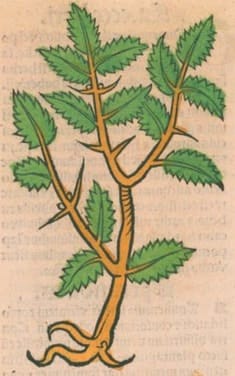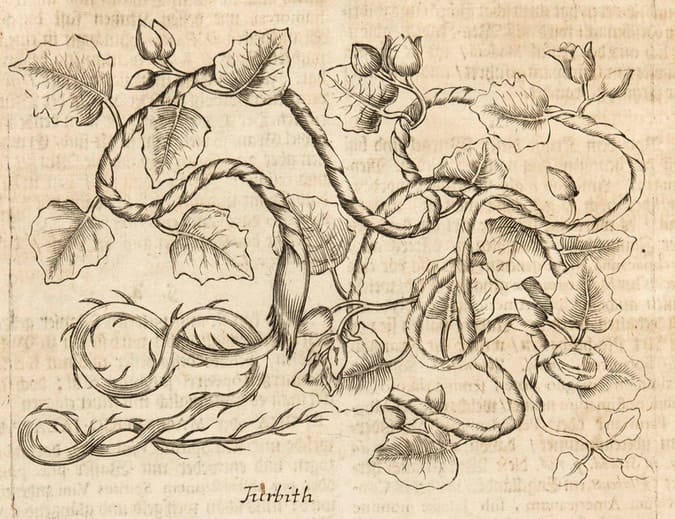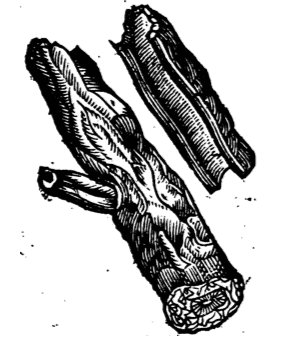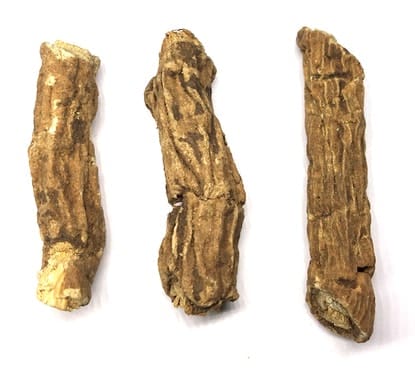Turpeth, TurbithTurpethumTrivrita, Tri-vrta (Ayurveda) Nishoth (Hindi) Turbud, Turbud Mujaffif, Turbud Safed (Unani) |

|

|
 Arabian Turbith
Arabian TurbithOrtus Sanitatis, Meydenbach, 1491
 Turbith
TurbithMuseum Museorum, Valentini, 1704
 Turbith Root
Turbith RootHerbario nuovo, 1667 |
 Turbith root
Turbith root(Calcutta Unani College, Adam, 2019) |
 Members CLICK HERE for the PRO VERSION
Members CLICK HERE for the PRO VERSIONBotanical name:
Operculina spp.
- O. turpethum (syn. Ipomoea turpethum, Convolvulus turpethum, Merremia turpethum, Spiranthera turpethum; Convolvulus triqueter, C. anceps, Ipomoea anceps, I. diplocalyx, I. turpethum var. anceps, I. silvana var. heterophylla, Operculina triquetra, Argyreia alulata)–White variety
- O. petaloides–Black variety
In India there are Black and White varieties. The Black variety is O. petaloides, the white variety is O. turpethum.
Parts used:
Root-bark (pith removed). The best is gummy, and came form Turkey. A lesser type is from India.
Temperature & Taste:
Very Warm, dry. Sweet, Bitter, Pungent
Classifications:
3K. EXPECTORANT
Preparers and Purgers of Phlegm
Preparers and Purgers of Melancholy
Laxative, Purgatives and Cathartics
Uses:
1. Clears Phlegm and Damp:
-phlegm obstructing the Chest with Cough, Asthma
-Phlegm and Damp clouding the Brain and senses
-Wind-Damp joint pain including Arthritis and Rheumatism
-Phlegm masses including Scrofula and Lymphadenitis
-Edema and Jaundice from a cold and damp cause
2. Purges Melancholy:
-Melancholy, Psychosis
-Syphilis, Scabs, Leprosy and other Skin diseases
-adjunct for Tumors, Fibroids and Cancers
Dose:
… available in PRO version
Comment:
… available in PRO version
Substitutes:
… available in PRO version
Correctives:
… available in PRO version

Main Combinations:
1. To purge Phlegm from the body:
i. Phlegm, Asthma, Edema, Turbith with … available in PRO version
ii. Turbith with Ginger, … available in PRO version
iii. Turbith with … available in PRO version
2. Edema:
i. Turbith, … available in PRO version
ii. Turbith, … available in PRO version
3. For Damp Joint pain:
i. Turbith … available in PRO version
ii. Rheumatism, Lumbago, Turbith with … available in PRO version
4. Rheumatic and Paralytic diseases from Damp, Turbith with … available in PRO version
5. Melancholy and Psychosis:
i. Melancholy, Turbith, … available in PRO version
ii. Turbith, … available in PRO version
iii. Turbith with … available in PRO version
6. Scrofula, Turbith with … available in PRO version
7. Chronic skin diseases, Turbith, … available in PRO version
8. Hemorrhoids, Turbith with … available in PRO version
9. Obesity, high cholesterol:
i. Turbith with … available in PRO version
ii. Turbith, … available in PRO version
10. Jaundice, Turbith with … available in PRO version
Major Formulas:
Infusion for Mixed Humors Compound (Mesue)
Powder of Turbith (Avicenna)
Powder to Purge Phlegm (Unani)
Powder of Three Solutives (Augustine Pharmacopoeia)
Compound of Turbith with Anise
Powder to Purge in Ascites (Nicholas)
Powder for Ascites (Isaac)
Troches for Back and Sacral Pain (Nicholas)
Electuary of Turbith (Zenon)
Electuary of Turbith and Agaric
Electuary for Asthma (Gereonis)
Indian Electuary Lesser (Mesue)
Triphala Electuary to Purge Phlegm and Black Bile
Pills of Agaric (Mesue)
Pills of Agaric (Avicenna)
Pills for Arthritis (Nicholas)
Pills to Cleanse the Chest
Foetid Pills Major of Galen
Greater Polycrest Pills
Cautions:
1. Not used during Pregnancy or in young Children
2. Not used in Yin deficiency
3. Use cautiously and avoid overdose
Toxicity:
LD50 of ethanol extract was 1917.66 mg/kg in mice.
Main Preparations used:
Diaturbith, Diaturbith with Rhubarb, Pills of Turbith, Vinegar of Turbith, Extract
|
‘This drug, which bears the Sanskrit names of Triputa, “three-angled”, Trivrit, “three-fold,” Kutarana, Tinti and Nindika, is described in the Nighantas as pungent, cathartic, dry, sweet and hot; a dispellent of wind, fever, phlegm, bile and melancholy, and bitter and digestive. Sanskrit writers mention two varieties, Sveta— ” white,” and Krishna or Shama,”black”; the latter kind bears the names of Kala, Kalaparni and Kalameshi, and is described as a violent purgative. Its source has not been satisfactorily ascertained, but it is supposed to be the root of Lettsomia atropurpurea, Clarke, a native of Nipal and Sikkim. I.Turpethum is sacred to Siva, to whom the flowers are offered by the Hindus. It is one of the most common native cathartics, and has probably been in use all over India from a very early date. The usual method of administration is to rub down about a drachm of the root or stem with water, and add to it some rock salt and ginger, or sugar and black pepper. Under the name of Turbud, an Arab corruption of Triputa, Mahometan writers also mention two kinds, white and black, and direct the black to be avoided on account of its poisonous properties, which are said to resemble those of Hellebore. As regards the properties of Turbud they say that it is a drastic purgative of phlegmatic humors and bile; its action is promoted by combination with ginger; it is particularly beneficial in rheumatic and paralytic affections. Combined with chebulic myrobalans it is useful in melancholy and dropsies. Ainslie says— “The Convolvulus Indicus alalus maximus had long a place in the British Materia Medica, but of late years has fallen into disuse. I find it mentioned by Avicenna under the name of Turbud; but the first among the Arabs who prescribed it was Mesue (see Spreng., Rei |
Herbaria, Vol. 1, p. 249), also Rhazes (c.173). Alston in his Materia Medica speaks of turpeth as a strong and resinous cathartic, and recommended in his days in gout, dropsy and leprosy. The plant is known to the modern Greeks by the name of [?]; it is a native of the Society and Friendly Isles, as well as of India, of the New Hebrides and of New Holland. Virey, in his Histoire Nalurelle des Medicaments (p.184), speaks of the root of the Convolvulus Turpethum as more drastic than the common jalap, which, however, it does not seem, is to be found in India.” (Mat. Ind. II., p.384.) Wallich, Gordon, and Glass considered this drug to be of considerable value as a cathartic. Sir W. O’Shaughnessy (Beng. Disp., p. 504), found it so uncertain in its operation that he pronounced it unworthy of a place in the Pharmacopoeia. In this opinion he is undoubtedly correct, as the active resins are present in the root in a much smaller proportion than in jalap, but as the drug is very cheap it might be used with advantage for preparing the commercial resin. Turpeth when administered by the mouth excites irritation of the stomach with nausea, colic, and watery, mucous stools; in excessive doses it excites inflammation of the gastro-intestinal mucous membrane and bloody dejections. Like jalap it is an hepatic stimulant, increasing the secretion of biliary matter and rendering it more watery. Being a hydrogogue cathartic it is useful for the removal of dropsical effusions, and in such cases it acts best in combination with ginger and bitartrate of potash. The dose should be about double that of the ordinary jalap powder of commerce, equal to from 4 to 5 grains of the resin. (Pharmacographia Indica, Dymock, 1891) |
